The cultural curators reframing our private and commercial collections
From seasoned collectors to enthusiasts just starting out, private buyers and corporate entities are increasingly looking to art consultants to impart their discerning eye, global connections and investment nous.
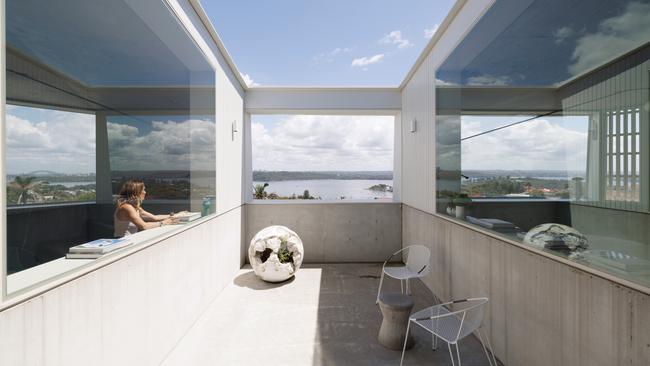
What we choose to put on our walls has always said a lot about us. But these days, it’s not just institutions and corporate giants who are seeking the experienced eye of an art curator to maximise cultural currency or return on investment. Private citizens, alongside our leading architects and designers, are increasingly teaming up with independent consultants to ensure art is anything but a decorative afterthought in residential and commercial developments around the country.
Nina Pether has been an art consultant at Justin Miller Art for 14 years, working with both private individuals and corporations to provide guidance and recommendations on collecting and curating for interiors and bespoke commissions.
Rather than representing artists in a gallery setting, the business offers impartial advice on collecting at all price points, while also facilitating collaborations with artists and galleries locally and overseas, whether for a residence, yacht, public space, corporate HQ, hotel or commercial entity.
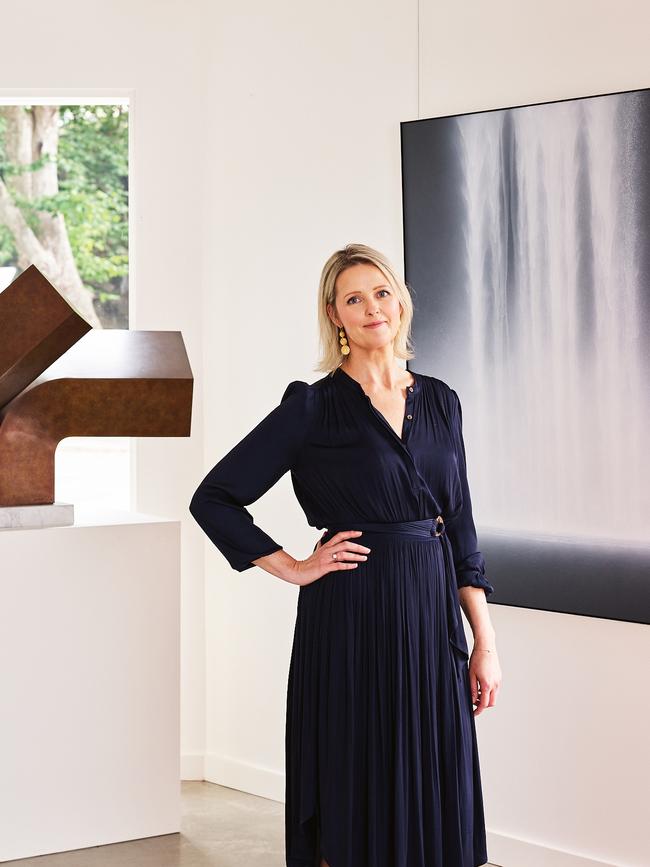
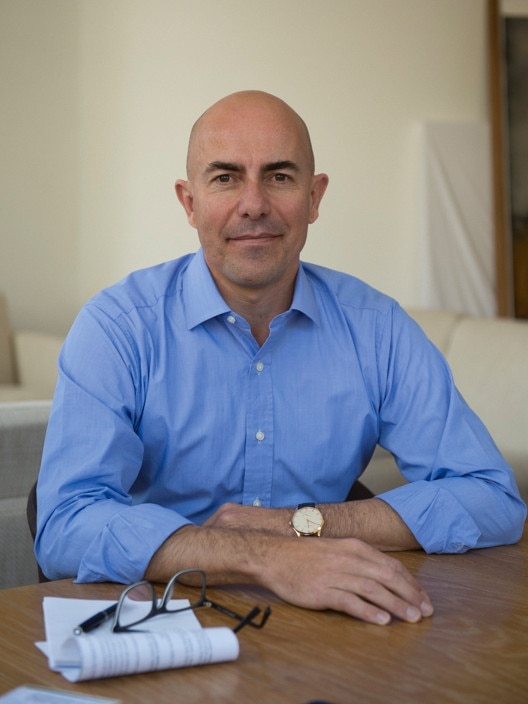
Pether’s clients may be predominantly based in Australia, but post-covid she has witnessed the rapid globalisation of the arts sector. “There is a growing appetite among Australian collectors to invest internationally, in particular in modern and contemporary art,” she says, noting the local interest in works by Antony Gormley (read our interview with Gormley on page 88), William Kentridge, Yayoi Kusama, Barbara Hepworth, Hiroshi Senju, Louise Bourgeois and Joan Mitchell, in particular.
“There has also been a rise in artists overseas, and their dealers, looking for greater representation in private and institutional collections in Australia,” she adds, “so there are interesting opportunities for our collectors to secure an artist’s work that previously would have been unattainable or certainly challenging to secure.”
This type of liaison work has become a major focus of her role. “Travelling to art fairs and nurturing relationships with dealers overseas is key to being able to assist clients in accessing and investing in art more broadly,” she says.
The range of forms of interest to Pether’s clients is also expanding. “A home with a diverse selection of contemporary, traditional, Indigenous, photography and sculpture is all the more unique and interesting. This has been a significant shift,” she shares, adding that the placement of outdoor sculpture in residential spaces has increasingly become a trend.
Pether often works with architect Blainey North, as well as Thomas Hamel & Associates, Archer Design and Dylan Farrell Design, adding that a significant aspect of her work is teaming up with architects and interior designers from the concept stage through to project completion.
“She’s amazing with sourcing work from great dealers all around the world for us,” North tells WISH. “From Picasso to Senju, she has the contacts that not many others have in Australia.”
For North, art is always an early consideration. “As we are designing, we are thinking about where art will sit, and allocating particular areas for it in the plans,” she explains. “We also have an idea of the role we want the art to play in the room. Sometimes it’s about bringing texture to a space, others it’s about softness or colour,” she says, noting a recent embrace of “bright, happy works”. “Other times, it’s perspective, so in this way, the artwork selection tends to be less about trend and more about it contributing to the harmony of all parts.”
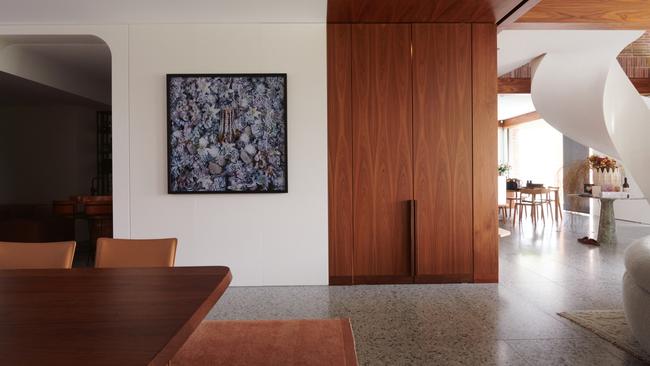
Another growing global trend that Pether also champions is the increased recognition of female artists. “Based on findings in the latest Artprice Art Market Report 2023, transactions for women artists has doubled in the past five years,” she says, pointing to Yayoi Kusama, Cecily Brown, Georgia O’Keefe, Joan Mitchell and Louise Bourgeois as the top five performing female artists globally. “These artists are still relatively ‘affordable’ in comparison with their male contemporaries, and it is an exciting area of opportunity.” She also namechecks London-based art historian, curator and podcaster Katy Hessel. “Her book The Story of Art Without Men is a must-read as it unveils so many female artists over the centuries who have been completely overlooked.”
Locally, Pether says this movement is taking hold with the growing demand for work by Emily Kngwarreye, Cressida Campbell, Bronwyn Oliver, Rosalie Gascoigne and Ethel Carrick. “For the first time in Australian art history, two female artists were included in the top 10 most-traded in 2023: Emily Kngwarreye and Cressida Campbell.”
Commercial curation has also turned over a new leaf since the pandemic as organisations look for innovative ways to draw employees back to the workplace and also to showcase core values. “There has been a shift towards art for purpose, meaning artwork displays that have a very clear message that is aligned with an organisation’s environmental, social and corporate governance,” adds Pether, who has curated exhibitions to showcase the importance of sustainability, supporting remote and disadvantaged communities, awareness around disability and social issues.
Art adviser Mark Hughes has also noticed this greater awareness and consideration of art for all. “It’s not just senior partners’ [offices] and art for the boardroom,” he shares. “Art has a new kind of ‘wellness’ value in the workplace.”
Hughes, who founded his business in 2011 after 21 years in the commercial gallery world, has been working closely with architect and MCA board member Nick Tobias of Tobias Partners for the past 15 years.
“The breadth of his knowledge and his access to an incredible diversity of art across the globe always astounds me,” Tobias shares. “Mark has a way of educating his > clients in a respectful way that allows them to see new layers of beauty in things through a deeper understanding. Art is about connection and Mark knows how to create that no matter what the level of the client.”
Together the pair maps out a unified approach for both commercial and residential projects. “We are doing more and more projects where art has to be integrated as part of the construction process, be it outdoor sculpture, art integrated into cabinetry or other interior wall elements, art as decorative lighting or even murals, painted or sculpted,” explains Tobias.
“We also often take pictures of works clients might be interested in and superimpose them in our 3D model of the completed house while it’s still a building site.”
A recent change that Hughes has noticed is in the attention span of the collector. “Buying work from PDFs and spending less time in commercial galleries isn’t a
good thing, but it is apparent,” he says. “People have less time, rely more on art fairs and the advice of good advisers. Our industry is growing as people recognise the time and effort we save them.”
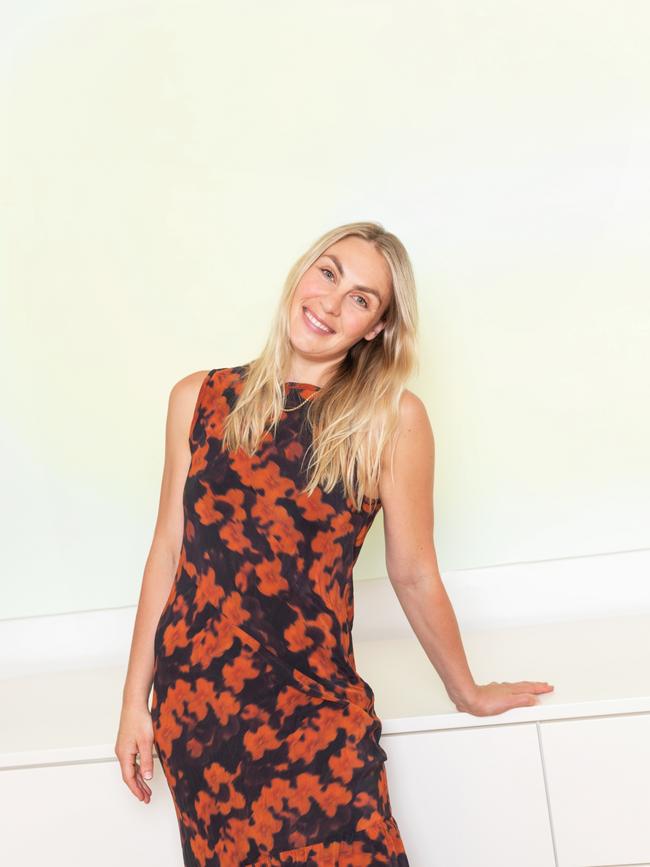

Fellow curator Anna Shapiro Taylor sees the positive in this new approachability. “The art world is becoming more inclusive and accessible, with efforts to dismantle barriers to entry and challenge elitist attitudes,” she says.
Even the actual buying experience has shifted towards digital platforms facilitating sales over the traditional showrooms and auction houses. This shift is driven by younger clients who initially gained confidence purchasing online during the pandemic.
Shapiro Taylor’s own childhood was coloured by being “dragged along by her parents” from one art gallery to the next, while her teenage years were spent behind the front desk of her father’s Shapiro auction house on Queen Street in Sydney’s Woollahra.
“I grew up in a home filled with art and objects,” she shares. “My mother was an art adviser and my father an obsessive collector of objects big and small. Rooms in our house changed with great frequency to accommodate new artists or auction finds.”
In her twenties, Shapiro Taylor worked across New York’s commercial and public arts sectors and back in Sydney at art consultancy Articulate and at Bangarra Dance Theatre. Then, by chance, a friend from high school moved into a “grown-up” house and asked for her to help source artworks. “The timing was good as I had just had my second child and I appreciated the flexibility. Then word of mouth brought me the next client and I realised it was time to create a business.”
She often teams up with interior designer Tamsin Johnson, who says Shapiro Taylor “has a refreshingly broad palette”.
“I love working with couples,” Shapiro Taylor adds. “The process often unlocks some uninhabited conversations. And if clients are early in their collecting journey, I advise towards a larger scale work that acts as an anchor to grow from.”
On the subject of growth, she sees the biggest industry transformation coming from the digital realm. “NFTs and Instagram are shaking up the art world; NFTs are like digital treasure maps for artists, while Instagram is the ultimate art gallery where everyone’s invited to the party.”
Emilya Colliver, of consultancy Art Pharmacy, is someone who recognised this shift early on, founding sister digital art business, Sugar Glider Digital. “To respond to the changing demand, we developed an incredible library of digital artwork just for our clients,” says the author of Making Art Matter and The Art Project, who is currently working with Cox Architecture and Charter Hall on 555 Collins Street, Melbourne.
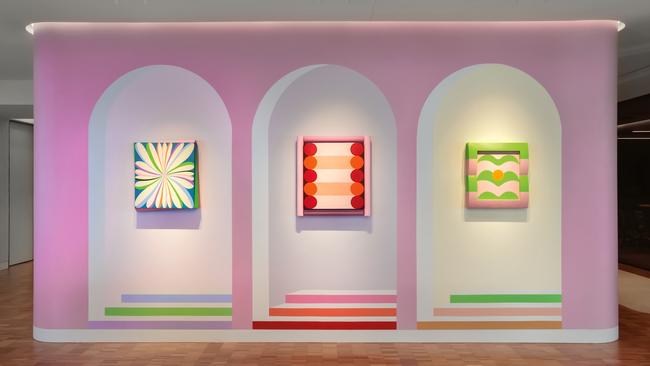
“Many of our clients have unusual and large spaces with a specific brief in mind; this leads to mainly commission-based artworks. Currently, the business has approximately an 80 per cent commission and 20 per cent acquisition split.”
Her advice for new collectors is to buy with their heart and to consider purchasing art as a memento of a significant life event. “Ceramics are often a great place to begin your collecting journey as they can be more affordable and still achieve a lasting impact.”
Viola Raikhel, managing director of 1858 Ltd Art Advisory, may be Sydney-based, but her clients – a mix of museums, private banks, financial institutions, family offices, luxury brands and Forbes 500 ultra high-net-worth (UHNW) individuals – hail from places as far flung as Geneva to Gstaad, London to Los Angeles.
“My expertise is navigating the market and minimising risk for clients,” she explains. “My advice is always focused on applying the same sort of due diligence towards art investments as you would apply to your other assets.
“The art market is not regulated and many unscrupulous sorts try to take advantage of this, which is why at the top end of the market, collectors need a trusted adviser to navigate,” she says, adding that Alexander Calder, Lucio Fontana and Daniel Arsham (read more about Arsham on page 38) are currently her most in-demand artists.
Physically protecting her client’s collections is another key part of the service. “We work with clients to establish security protocols. Some have replicas hanging in their homes if there is a high security risk, with the original safely stashed away in the Geneva Freeport, for example.”

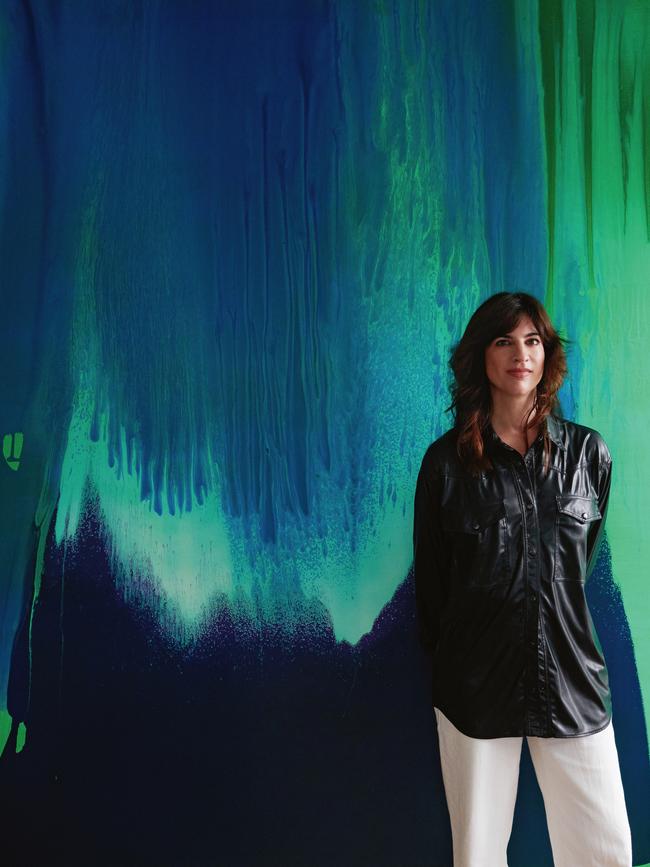
Technology, Raikhel says, is also changing the way we verify and protect art. Quoting the Deloitte and ArtTactic 2023 Art & Finance Report, she shares that “80 per cent of the next generation of collectors [aged 35 and under] believe in the potential of technology [like blockchain] to be an asset register for art and collectables”.
Succession plans for art collections are the other end of this spectrum. “We do a lot in this space,” she says, “helping clients with philanthropic structures, securing art lending and other trust structures.”
Another important aspect of her role is predicting – and managing – the risk of an artist becoming too trendy or even overexposed.
“Funnily, a successful artist will be considered sought after and in high demand – there will be waiting lists with upcoming exhibitions and books – a trendy artist will become overexposed and outdated,” she adds. “It’s about knowing how to understand that nuance that makes all the difference.”
Ali Hillman, founder of Friday Trampoline art consultancy, and development manager at Artspace, a public gallery in Woolloomooloo, Sydney, has a similarly global perspective having returned home from London mid-pandemic.
“Balancing commercial and public art interest is key to this issue,” begins Hillman. “The role public collections play in fortifying an artist’s legacy is crucial and consequently, commercial galleries often feel the need to consider commercial demand for an artist’s work in association with representation across institutional collections.
“It’s also important for artists in high demand to purposefully maintain an archive that hopefully informs a retrospective one day. When works consistently disappear into private collections, it’s hard to create permanence and impact around an artist’s career.”
In London, Hillman began her art journey as group curator for Microsoft co-founder Paul Allen’s members’ clubs, which included sites in London and LA. “I was able to build artistic programs for public spaces and patron or membership-based groups and it allowed me to grow audiences for emerging artists, creating opportunities for audiences to engage with their work outside of a traditional gallery setting,” she recalls.
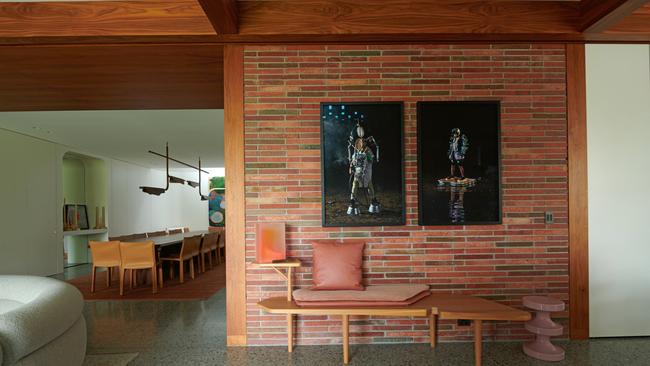
It is work she has continued at home with Sydney members’ club Vault House, where she recently commissioned Sydney-based artist Daimon Downey to create Brutalist-inspired works in response to the industrial architecture of the group’s latest property on Clarence Street. “Art increasingly operates as culture capital, and key art placement can be particularly significant during the launch phase of new commercial entities especially in hospitality-driven ventures like hotels, restaurants and clubs,” she says.
For Hillman, commissioning work remains a huge privilege, even if it does come with added pressures. She recalls working with Shan Turner-Carroll on an especially personal undertaking involving a telepathic session with Connie Mitchell of musical group Sneaky Sound System. “Connie and Shan never physically met, instead synchronising creative expression in a highly personalised artwork for Connie’s husband and Sneaky counterpart Angus McDonald,” shares Hillman. “Not many collectors can boast about work in their collections being telepathically bespoke.”
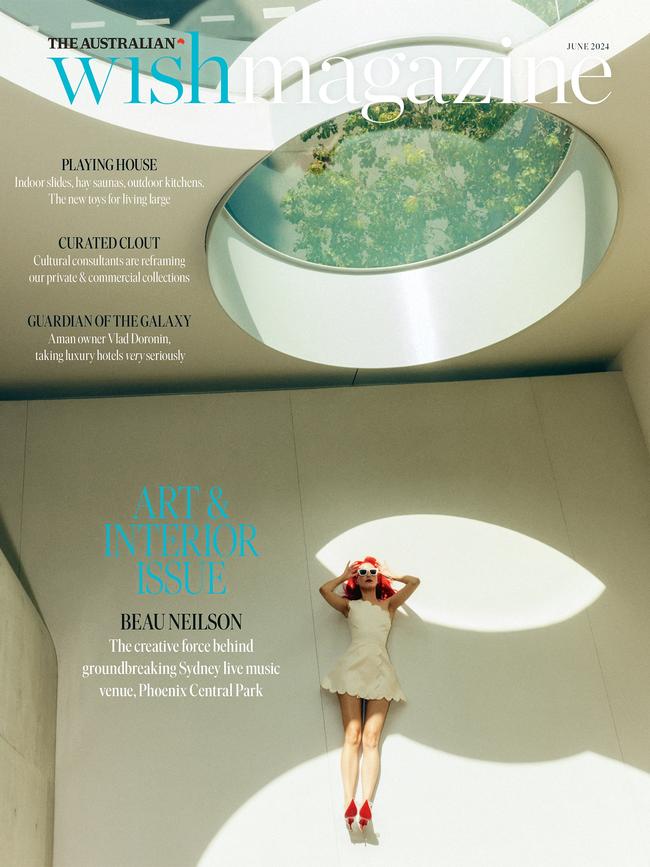
This story is from the June issue of WISH.




